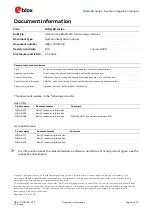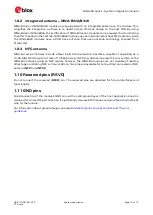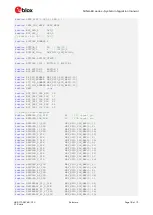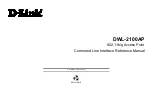
NINA-B3 series - System integration manual
UBX-17056748 - R13
System description
Page 10 of 72
C1-Public
DC/DC efficiency should be evaluated as a tradeoff between active and idle duty cycles of the specific
application. Although some DC/DC can achieve high efficiency at extremely light loads, a typical
DC/DC efficiency quickly degrades as idle current drops below a few mA, greatly reducing the battery
life.
Due to the low current consumption and wide voltage range of the NINA-B3 series module, a battery
can be used as a main supply. The capacity of the battery should be selected to match the application.
Care should be taken so that the battery can deliver the peak current required by the module. See the
NINA-B3 series data sheet
for the electrical specifications.
It is best practice to include decoupling capacitors on the supply rails close to the NINA-B3 series
module. But depending on the design of the power routing on the host system, capacitance might not
be needed.
1.5
System function interfaces
1.5.1
Module reset
You can reset NINA-B3 modules by applying a low level on the
RESET_N
input pin, which is normally
set high with an internal pull-
up. This causes an “external” or “hardware” reset of the module. The
current parameter settings are not saved in the non-volatile memory of the module and a proper
network detach is not performed.
1.5.2
Internal temperature sensor
The radio chip in NINA-B3 contains a temperature sensor used for over temperature and under
temperature shutdown.
⚠
The temperature sensor is located inside the radio chip and should not be used if an accurate
temperature reading of the surrounding environment is required.
1.6
Debug
–
Serial Wire Debug (SWD)
The primary interface for debugging is the SWD interface. NINA-B30 series modules provide an SWD
interface for flashing and debugging. The two pins
SWDIO
and
SWDCLK
should be made accessible
on header or test points.
The SWD interface is disabled on the NINA-B31 series modules.
1.7
Serial interfaces
⚠
As NINA B3 can be used with both the u-connectXpress and open CPU based applications, based
on the Nordic SDK, the available interfaces and the pin mapping may vary. For detailed pin
information, see
Pin configuration and function
1.7.1
Universal Asynchronous Serial Interface (UART)
NINA B3 provides a Universal Asynchronous Serial Interface (UART) for data communication.
The following UART signals are available:
•
Data lines (RXD as input, TXD as output)
•
Hardware flow control lines (CTS as input, RTS as output)
•
DSR and DTS are used to set and indicate system modes











































